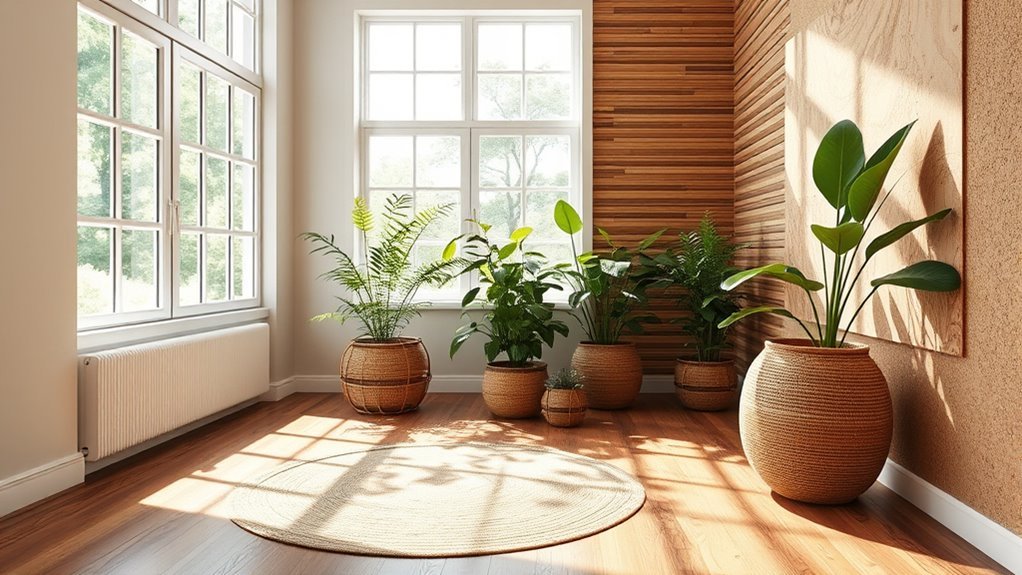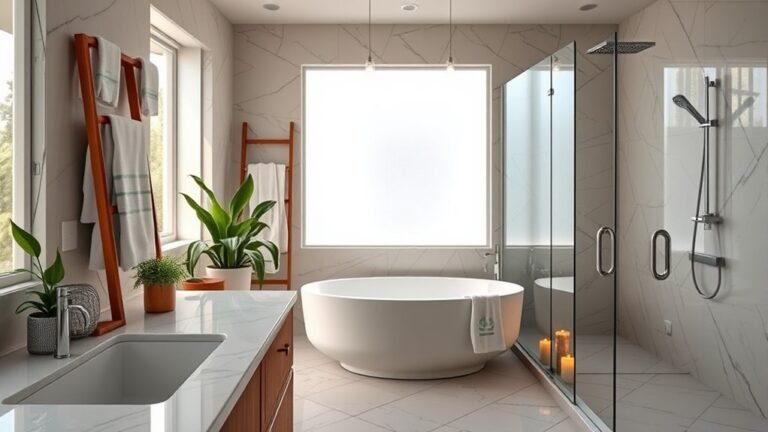Natural Alternatives to Laminate
If you want a natural alternative to laminate, consider hardwood, bamboo, cork, natural stone, or linoleum. Hardwood offers durability and timeless beauty with refinishing options. Bamboo and cork are renewable, eco-friendly materials requiring less water and pesticides. Natural stone like granite and marble delivers exceptional durability and unique aesthetics. Linoleum is biodegradable and low maintenance. These options enhance sustainability, indoor air quality, and long-term value. Explore these choices to find the perfect sustainable floor for your space.
Benefits of Hardwood Flooring
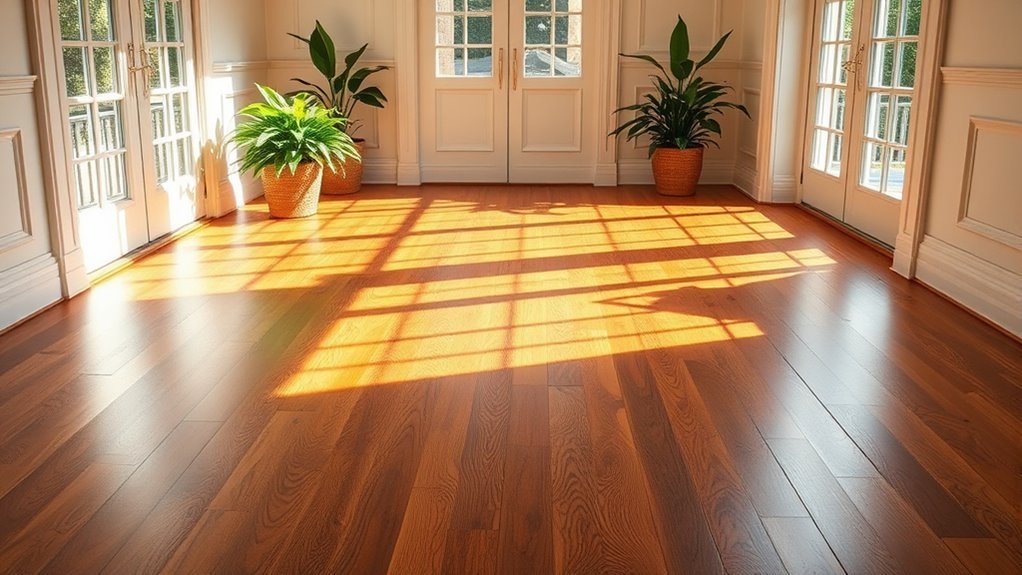
Although laminate flooring offers affordability and easy installation, hardwood flooring provides distinct benefits that make it a superior long-term investment. When you choose hardwood, you tap into hardwood advantages like durability and the ability to be refinished multiple times, extending the floor’s lifespan considerably. Unlike laminate, hardwood’s natural composition enhances indoor air quality by avoiding synthetic chemicals. Flooring aesthetics also play an essential role; hardwood’s unique grain patterns and rich tones offer a timeless, authentic look that complements diverse design styles, giving you the freedom to personalize your space. Additionally, hardwood floors improve home value and are easier to repair, reducing long-term maintenance costs. If you value sustainability and a natural environment, hardwood flooring presents a scientifically sound, aesthetically pleasing option that supports your lifestyle freedom.
Exploring Bamboo as a Sustainable Option
Because bamboo grows rapidly and requires minimal resources, it has become a popular sustainable alternative to traditional hardwood and laminate flooring. You’ll appreciate how bamboo flooring supports bamboo sustainability through efficient land use and fast regeneration. Its natural strength and resilience make it ideal for various environments, offering durability without compromising eco-consciousness. When considering bamboo flooring, keep in mind:
- It sequesters carbon dioxide effectively, aiding climate change mitigation.
- Its cultivation demands less water and no pesticides compared to conventional hardwoods.
- Bamboo’s rapid growth cycle means quicker replenishment, preserving forest ecosystems.
Choosing bamboo flooring grants you freedom from environmentally harmful materials while maintaining a sleek, natural aesthetic. It’s a practical, scientifically supported option if you want to align your living space with sustainable values.
Cork Floors: Comfort and Eco-Friendliness
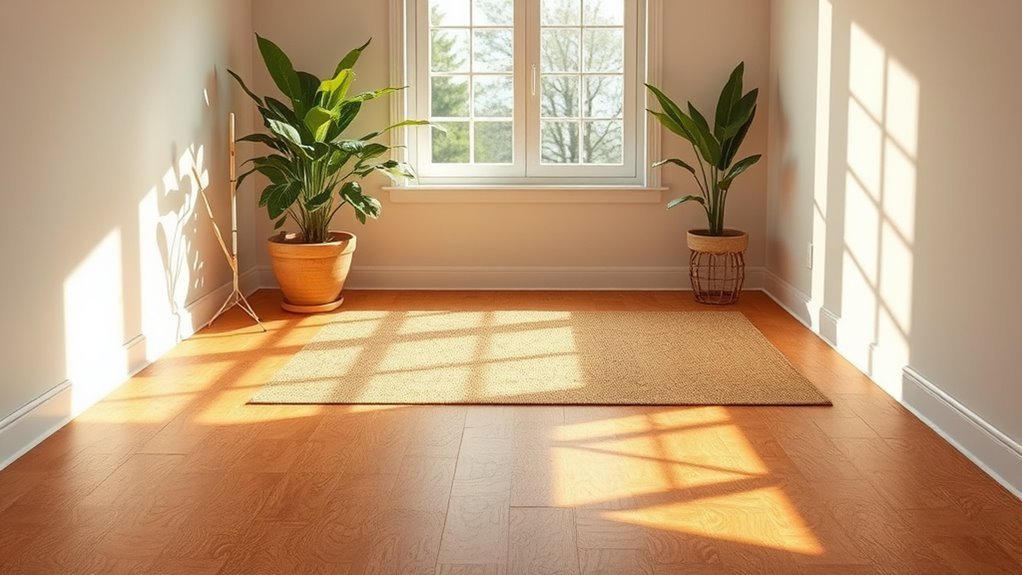
In addition to bamboo, cork presents another sustainable flooring option that combines comfort with environmental benefits. Derived from the bark of cork oak trees, cork flooring is renewable and harvested without tree felling, preserving ecosystems. One of the key cork benefits is its unique cellular structure, which provides natural cushioning and thermal insulation, reducing fatigue during prolonged standing and enhancing energy efficiency in your space. Cork aesthetics offer a distinctive, warm appearance with subtle patterns that vary naturally, adding character while maintaining a modern look. Additionally, cork is hypoallergenic and resistant to mold and mildew, promoting healthier indoor air quality. Choosing cork floors means you embrace a material that supports environmental stewardship without compromising on comfort or style, giving you the freedom to create a sustainable, inviting home environment.
Natural Stone: Timeless and Durable
When choosing natural stone, you’ll find options like granite, marble, and slate, each with distinct mineral compositions and physical properties. These stones offer exceptional durability, resisting wear, heat, and moisture far better than laminate. Understanding these characteristics can help you select a material that combines longevity with timeless aesthetic appeal.
Types of Natural Stone
Natural stone offers a variety of options that combine aesthetic appeal with exceptional durability, making it a preferred choice for those seeking timeless surfaces. When selecting natural stone, you’ll encounter diverse types, each with unique properties suitable for different applications like granite countertops or marble tiles.
Here are three common types you might consider:
- Granite: Highly durable and resistant to scratches, ideal for kitchen surfaces.
- Marble: Known for its elegant veining and smooth texture, often used in tiles and decorative elements.
- Slate: Offers a fine-grained texture and natural slip resistance, great for flooring and outdoor use.
Understanding these types helps you choose the right stone that balances beauty and function, giving your space a natural, lasting appeal without compromising freedom in design.
Benefits of Stone Durability
Choosing the right type of stone isn’t just about appearance; its durability substantially impacts longevity and maintenance. When you select natural stone, you benefit from materials that resist wear, scratches, and environmental damage far better than laminate. This durability means less frequent repairs or replacements, reducing your stone maintenance efforts over time. Furthermore, natural stone maintains its aesthetics despite heavy use, preserving its timeless appeal and enhancing your space’s value. Stones like granite and quartzite offer exceptional hardness, while marble provides elegance with moderate durability. Understanding these differences lets you choose a stone that aligns with your lifestyle and desired freedom from constant upkeep. Ultimately, investing in durable natural stone guarantees your surfaces remain both functional and visually striking for years to come.
Linoleum: A Traditional Yet Green Choice
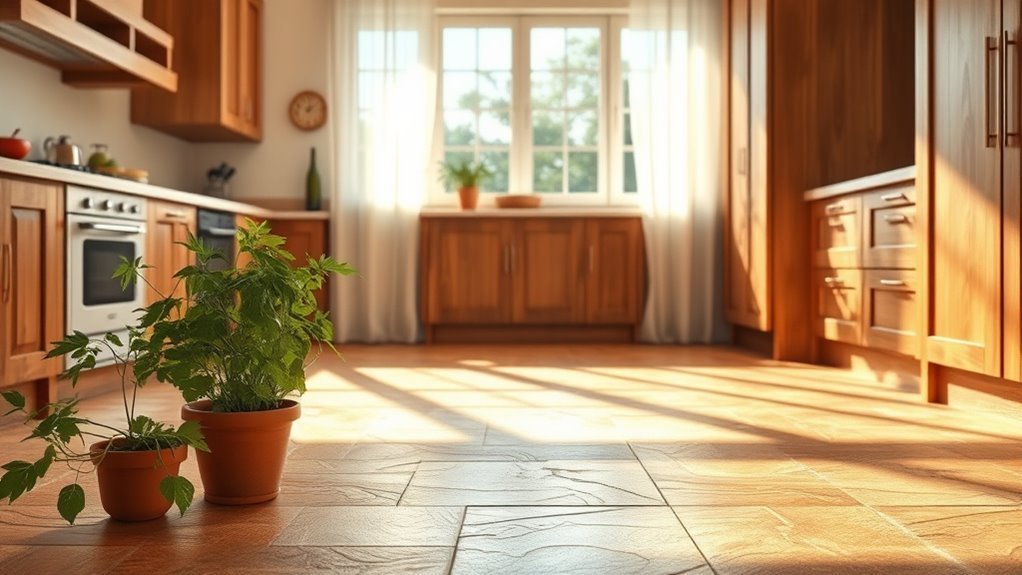
You’ll find linoleum offers an eco-friendly option due to its natural composition of linseed oil, wood flour, and cork dust. Its durability rivals many synthetic floors, requiring minimal maintenance to preserve its lifespan. Understanding proper care techniques will help you maximize both its performance and sustainability benefits.
Eco-Friendly Material Benefits
Although linoleum has been around for over a century, it remains one of the most environmentally responsible flooring options available today. When you choose linoleum, you’re opting for a product derived from sustainable sourcing and renewable resources like linseed oil, wood flour, and cork dust. This natural composition not only reduces environmental impact but also supports ecological balance.
You’ll appreciate these eco-friendly benefits:
- Biodegradability: Linoleum breaks down naturally at the end of its lifecycle, minimizing landfill waste.
- Low VOC Emissions: It contributes to improved indoor air quality by releasing negligible volatile organic compounds.
- Resource Efficiency: Its manufacturing process demands less energy compared to synthetic flooring alternatives.
Durability and Maintenance Tips
Linoleum’s natural composition not only benefits the environment but also contributes to its durability and ease of maintenance. You’ll appreciate its inherent scratch resistance, helping preserve appearance despite daily wear. Proper moisture control is essential; linoleum resists water damage when sealed effectively, preventing warping or mold. To maintain freedom from frequent repairs, regular cleaning with mild detergent and prompt spill removal is advised.
| Maintenance Task | Frequency | Purpose |
|---|---|---|
| Sweeping | Daily | Remove debris, prevent scratches |
| Damp Mopping | Weekly | Clean surface, maintain finish |
| Sealing | Every 3-5 years | Enhance moisture control and durability |
| Spill Cleanup | Immediately | Prevent staining and damage |
| Scratch Repair | As needed | Preserve appearance and integrity |
Reclaimed Wood for Unique Character and Sustainability
When selecting materials that balance environmental responsibility with aesthetic appeal, reclaimed wood offers a compelling option due to its unique character and sustainability benefits. You’ll appreciate reclaimed wood aesthetics that showcase natural grain, weathering, and historical marks, giving your space individuality unattainable with new wood or laminate. Beyond looks, sustainable sourcing reduces deforestation and landfill waste, aligning with eco-friendly principles. Consider these key advantages:
- Distinctive texture and color variations from years of natural exposure
- Lower environmental impact through repurposing existing materials
- Durability preserved by dense, aged hardwoods often used in reclaimed sources
Frequently Asked Questions
How Do Natural Flooring Options Affect Indoor Air Quality?
Imagine your home’s air as a clear mountain stream—when you introduce indoor pollutants, it becomes murky. Choosing natural flooring reduces VOC emissions, the invisible toxins that often seep from synthetic materials. By opting for natural options, you minimize these harmful emissions, improving indoor air quality and giving you the freedom to breathe easier. It’s a precise way to safeguard your health and create a cleaner, fresher living space.
What Is the Average Lifespan of Natural Flooring Materials?
You’ll find that the average lifespan of natural flooring materials varies widely, generally ranging from 20 to over 100 years depending on material durability. For example, hardwood can last up to a century with proper care, while cork and bamboo offer moderate longevity. These materials’ sustainability benefits also contribute to their appeal, as their durability reduces replacement frequency, helping you enjoy both environmental freedom and long-term performance without sacrificing quality.
Are Natural Floors More Expensive to Maintain Than Laminate?
When considering cost comparison, natural floors often have higher upfront expenses but lower long-term maintenance costs compared to laminate. Their maintenance requirements include periodic sealing or refinishing, which preserves durability and appearance. Laminate, while cheaper initially, may require full replacement sooner due to wear. So, if you value freedom from frequent repairs and want a durable surface, natural floors might be more cost-effective and less demanding over time.
Can Natural Flooring Be Installed Over Radiant Heating Systems?
Imagine warmth gently rising like morning sun rays beneath your feet—that’s radiant heating at work. When it comes to flooring compatibility, many natural floors, like engineered wood and bamboo, play well with radiant heating systems, thanks to their stability and heat conduction. However, solid hardwood requires careful selection and installation to avoid warping. You’ll want to consult manufacturers’ guidelines to guarantee your natural flooring harmonizes perfectly with radiant heating for lasting comfort and durability.
How Do Natural Floors Perform in High-Moisture Areas?
When you consider natural floors in high-moisture areas, it is crucial to recognize their varying moisture resistance. Some materials like bamboo and certain hardwoods offer moderate moisture resistance but still require proper sealing to maintain flooring durability. Others, like cork, have better natural resistance but can be sensitive to prolonged water exposure. To guarantee long-lasting performance, you’ll want to choose materials with proven moisture resistance and apply appropriate finishes to protect the floor.
